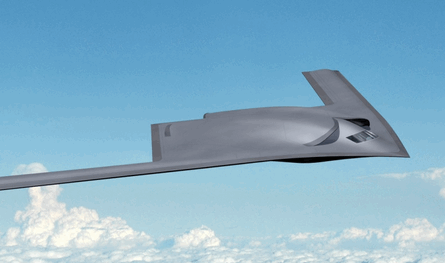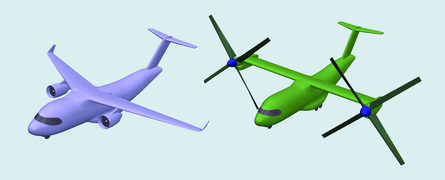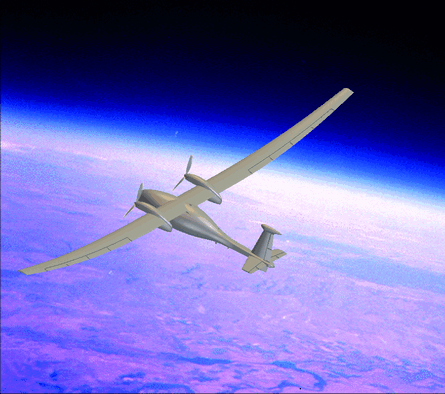Boeing's Phantom Works advanced research unit tries to "make dreams about the future of aerospace come true". However, it is the job of the manufacturer's Advanced Systems business to ensure that such dreams eventually become reality in a world characterised by increasingly stretched defence budgets and demand for shareholder returns.
An examination of the projects Advanced Systems is working on provides a glimpse through the keyhole at the type of air vehicles likely to be gracing our skies by the end of the next decade. These are typically aircraft that will fly faster, further, higher and more efficiently that anything in the inventories of the world's air forces today, and which in many cases are close to entering full-scale development in response to real-world requirements.
Advanced Systems is responsible for identifying and maturing new business opportunities for Boeing Integrated Defense Systems (IDS), and typically manages new-technology programmes until they reach the full-scale system design and development phase.
 |
|---|
© Boeing |
"We basically line up with the rest of the key [IDS] businesses, whether it be network and space systems, support systems or precision engagement and mobility systems, and we look at the future as well as continuing to drive technology to extend the current product lines," says David Koopersmith, vice-president of advanced precision engagement and mobility systems (APE&MS), the aeronautical unit of Advanced Systems.
Cutting Edge Technology
"We work with the three business units to develop cutting-edge technology, leveraging work done by our Phantom Works organisation and establishing new business opportunities where we see a key capability gap," says Koopersmith. "We are pursuing all the new business when it comes to new programmes and our concept of operations is typically to hand them off at the point of SDD."
Koopersmith came to his current role after leading Boeing's X-45N unmanned combat air system project for the US Navy. During his 29-year career he has worked on a diverse range of projects including the Boeing AV-8B Harrier II and F/A-18E/F Super Hornet and the Avionics Modernisation Program for the Lockheed Martin C-130.
The 2,000-employee Phantom Works develops core technologies while Advanced Systems identifies those that could be matured to establish so-called "white space" businesses. Once these core technologies have been readied for the SDD or "milestone B" phase, they are transitioned from Advanced Systems to the relevant business unit for implementation. We pull that innovation and invention out of Phantoms Works and make it relevant to the future of IDS, and in my case precision engagement and mobility systems," says Koopersmith.
A central plank of this work is rapid prototyping of hardware and software, and extensive use of simulation and modelling. "Prototyping has become even more important in the US framework of acquisition," says Koopersmith.
Advanced Systems continues to support the IDS business units through the execution of major defence contracts in an effort to "keep it sold" in an environment where programme cancellations are commonplace, and attract follow-on business.
Of the many advanced precision and engagement projects being worked on by Advanced Systems, one of the highest profile is the US air force's pending requirement for a next-generation bomber. Boeing has opted to team with Lockheed Martin for this contest and the pair face a tough fight to unseat Northrop Grumman, supplier of the air force's flagship B-2 Spirit stealth bomber.
New USAF Bomber
The USAF has revealed few details of its plans for the new bomber, other than to indicate that it is seeking an ambitious initial operational capability date of 2018, based on a manned subsonic design. The aircraft is expected to be required to carry an ordnance payload of 6,350-12,700kg (14,000-28,000lb) with an unrefuelled combat radius of 3,700km (2,000nm).
Koopersmith will say little about the image Boeing has released of its bomber concept other than to confirm that it is "very representative of what's in the public domain". One area where a significant improvement could be made over today's B-2 is in the sustainability of the low-observable materials that cover the aircraft, which are liable to degrade in the presence of moisture.
 |
|---|
© Boeing |
"We believe that it is very important for 21st century tactical and strategic assets to be much more reliable and maintainable than the earlier generations, and I think that's one of the things that we will be doing and investing in," says Koopersmith.
Next-Generation Airlifter
Another critical market for Boeing is next-generation tactical airlift for the US Army and USAF, and the company is under contract from the Air Force Research Laboratory (AFRL) to study an Advanced Joint Air Combat System (AJACS) transport. This would be capable of carrying a Future Combat System (FCS) army ground vehicle, which is too large to be carried in a Lockheed Martin C-130.
"Think of [AJACS] as a boosted-up C-130," says Koopersmith. "We're under contract to do a number of studies for different variants of a short take-off and landing aircraft to carry an FCS vehicle. "We've been maturing this capability, doing a fair amount of windtunnel testing looking at different levels of survivability of the configuration, and continue to look at advanced technology of this thrust-class engine, in underwing, overwing or semi-submerged configurations."
Key to wringing out the necessary performance from these designs will be advanced composites technologies, says Koopersmith, "because in this class of vehicle the structural weight becomes so critically important".
"Our starting point is basically the level of maturation of the composites on something like the 787, pivoting off all the other good work that's been invested in by Boeing."
The tactical airlifter work is taking place against a constantly evolving landscape, as Boeing has also received study contracts from the Aviation Applied Technology Directorate to look at joint heavylift solutions. The army and air force are looking to merge these sets of requirements together into what they call Joint Future Theater Lift (JFTL). More details are expected to emerge later this year on whether they are seeking short take-off or vertical take-off capability.
 |
|---|
© Boeing |
Virtual Warfare
"Something we're doing in the virtual warfare centre right now is simulations, as well as experiments, to understand the different benefits of vertical [take-off] versus STOVL [short take-off/vertical landing] in the next-generation tactical mobility asset," says Koopersmith.
One potential solution to the JFTL requirement is the Joint Cargo Air Lifter System (JCALS), which would apply a common fuselage to conventional and tiltrotor variants.
"We'll have to decide as we mature this concept if we're willing to pay the penalty to carry the unique vertical loads on the STOVL variant, or the unique STOVL loads on the vertical variant, but we believe that with the size and weight that the army is wanting to have lifted, a nearly-common fuselage could give a lot of benefit," says Koopersmith. He estimates that the weight penalty would "probably be 10% or less".
The tiltrotor version would be similar to an upscaled Bell Boeing V-22, but with a wing design optimised more for strategic lift requirements, as well as tactical operations where vertical lift capability is not required. The JCALS designs would feature common avionics, pressurised airframes, landing gear and empennage. The payload capability is expected to be in the 11,300-18,000kg class. "We anticipate that requirement is going to be [to carry] an FCS," says Koopersmith, adding that Boeing expects IOC to be set for "late next decade or early in the 2020s", subject to agreement between the army and air force on budgets and requirements.
Already existing in hardware form is the blended wing body (BWB) X-48B unmanned low-speed demonstrator, jointly sponsored by Boeing, NASA and AFRL, and which is currently being test flown at NASA's Dryden Flight Research Center.
Efficient Wing
"When we look at the future now for strategic lift and cargo, this kind of a wing is just very efficient and that's why we've invested, and are working with NASA and others to continue to mature this technology," says Koopersmith. The demonstrator has undertaken 15 of the 35 flights that are due to be completed by early next year. New technology engines and advanced aerodynamics are expected to enable a full-scale BWB to provide a 30% improvement in fuel efficiency compared with existing subsonic military transports.
"This is a 20ft [6.1m], 8.5%-scale of what we anticipate might be built in the future to actually meet a strategic lift requirement," says Koopersmith. "We really are focused on the potential military applications. This could become a family of vehicles depending on tactical or strategic needs. I think the next evolution would be some kind of manned demonstrator."
Talks with AFRL on building a manned demonstrator remain at a "fairly immature point. We're thinking about the size of vehicle. That would be manned so you would scale up from this, but clearly not be full scale."
Blackswift, meanwhile, is a joint Defense Advanced Research Projects Agency/air force project to fly a reusable Mach 6-plus demonstrator. Boeing plans to compete for the work, leveraging from its experiences on recent hypersonic research projects including the X-37, X-43A, HyFly and X-51A.
The Blackswift would be roughly the same size as a Lockheed Martin F-16 and would be capable of taking off and landing under its own power. "They're talking about a contract award this year, with it potentially flying in 2012," says Koopersmith. "This is hard, to get to a flying vehicle in 2012. We are continuing to mature a number of technologies in this area and talking with others in industry about how best to pursue this activity.
"We think this is an area where the technology is such that you've got to bring all the resources to bear within industry to take on something this challenging."
As well as faster, Advanced Systems is looking for ways to fly higher for longer through its studies of a high-altitude long-endurance (HALE) concept. This would offer an endurance of seven days-plus, carrying a 900kg multi-sensor payload.
Extreme Endurance
Extreme stratospheric endurance is ideal for missions such as battlefield and border observation, port security and telecommunications. "We continue to mature a number of technologies in this area," says Koopersmith. "One of the key enabling technologies is hydrogen propulsion, and lightweight structure becomes critically important here."
 |
|---|
© Boeing |
Yet to be determined is whether the HALE aircraft will be equipped with landing gear, as it would take off and land very slowly. Power will be provided by liquid hydrogen automotive engine, testing of which began last year on the ground. Boeing has just completed a second phase of maturity testing of the powerplant in an altitude chamber, which is capable of simulating operating conditions at 70,000ft.
IOC would be achievable "probably someplace late in the next decade, with the right maturation of technologies and customer investments", says Koopersmith.
Source: Flight International























